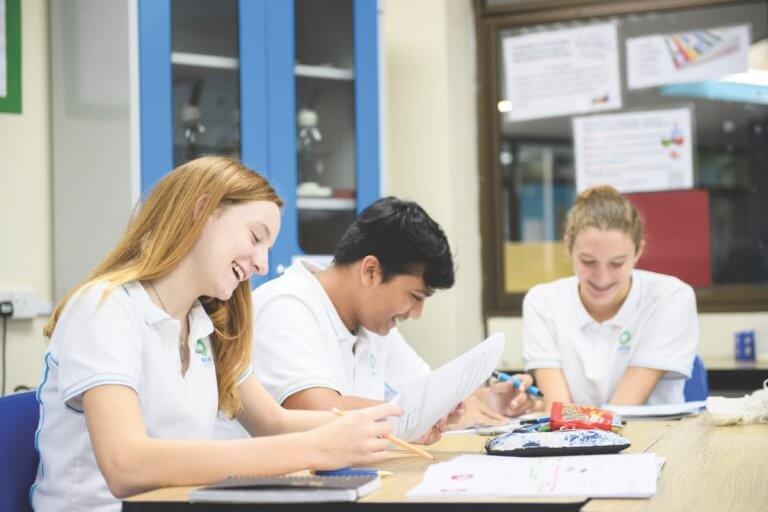
Applying to college is no easy feat. As the workplace becomes more competitive, graduates need to step up their game. This, in turn, forces universities to select only the best in a bid to make classrooms more engaging and fruitful.
In an admission system that seeks the perfect candidate, high schools are scrambling to make sure students fulfil what appears to be a vexing jumble of competing objectives.
Today, college admission teams are in search of applicants drawn from a stellar ‘holistic education’. This means the candidate sparkles with academic credentials, contextualised, of course, against their personal background, which is then judged by their non-academic pursuits in extracurricular activities.
(Almost) Perfect SAT/ACT scores? Check. Full marks on the International Baccalaureate modules? Check. Meaningful pursuit of extracurricular activities? Check. Personal essays that stand out? Check.
High schools that manage all the above are few and far between. Squeezing in sports, arts and counselling on top of maintaining high grades for each student is a tall order. Then there’s still the need to inculcate values, or what certain colleges dub the “Predictors of Success”, including values like empathy, curiosity, openness to change and the ability to overcome adversity.

Source: Australian International School
In Asia, the problem feels magnified. Far too many schools in its developing economies remain focused on rote learning and memorisation. Creativity and critical thinking are secondary priorities, despite the World Economic Forum listing them as some of the top skills we need for the 4th Industrial Revolution.
While it’s been deemed the cause for the Asian tigers’ success in international test results in maths, reading and science literacies, there is growing emphasis on transversal competencies, or what’s been deemed 21st century skills – broad terms referring to the skills, competencies, values and attitudes required for the holistic development of learners, such as: collaboration, self-discipline, resourcefulness and respect for the environment – moving away from “traditional academic” studies, such as rote learning.
While this shift is aimed at getting more into the world’s top colleges and universities, we must not forget the true purpose of school: maximising every child’s and teenager’s potential.
The key is to find a school that can do both. It’s a search that can feel daunting, but there are schools in Asia that lead the race in this aspect.
Here are five international schools in Asia that provide the best of both worlds; preparing students for the cutthroat world of college admissions while fulfilling each student’s unique potential.
JERUDONG INTERNATIONAL SCHOOL (JIS) – BRUNEI

Source: Jerudong International School
The aims of Brunei’s leading boarding and day school are clear and simple: to provide a holistic education through the integration of thinking skills, active engagement and language. This school strives to nurture leadership skills, to drive participation in a diverse range of activities and form strong relationships between staff, students and parents alike.
Jerudong’s commitment to this can be seen through the many and various programmes it offers year after year. In addition to preparing students to thrive in examinations and assessments, teachers give learners a passion to learn about the wider world.
Recently, a new leadership programme was launched to help students articulate better during interviews, as Asian children are typically known to fall behind their Western peers in this sense.
And it’s a formula that pays off – 75 percent of Jerudong’s IGCSE results were A* to B, while 2 students out of 228 globally achieved the perfect score of 45 in the International Baccalaureate (IB) exams.
Mups Hirse graduated from JIS in the Class of June 2018, and is already set to continue her studies at the University of Toronto as a proud recipient of the Pearson Scholarship.
“I owe my success to Jerudong International School because being in that environment, surrounded by amazing students and even more amazing teachers, is the reason why my secondary school years have been immensely memorable.”
SINGAPORE AMERICAN SCHOOL – SINGAPORE

Source: Singapore American School
Singaporean students’ performance in exams like the Programme for International Student Assessment is impressive. Trumping this would be hard, but the Singapore American School has its own strategies to do so.
For one, it focuses on the American school system, giving each student an individualised experience of academic and personal excellence. Learners are challenged to reach new heights both in the classroom and out. There are over 250 extracurriculars offered to students from kindergarten through to high school, ensuring every child grows into a well-rounded individual. It’s a fruitful strategy – The school boasts a 100 percent college acceptance rate.
The success of the school boils down to its commitment to “a culture of excellence, a culture of extraordinary care, and a culture of possibilities”. Achieving perfect GPA scores is only a fraction of what it wants for its students, guiding them to think beyond college success, be it through developing leadership skills in clubs like the Model United Nations, sending their experiments into space or joining eco-adventures to the Himalayas of Nepal.
BRITISH INTERNATIONAL SCHOOL HO CHI MINH CITY – VIETNAM

British International School Ho Chi Minh City
The largest international school in Vietnam is home to students from over 50 nationalities, aged 2 to 18 years old.
In this vibrant international community, students study music through a collaboration with the world-renowned Juilliard School, participate in diverse co-curricular activities, work alongside UNICEF on UN Sustainable Development Goals and give back to society through an embedded community service programme organised by a dedicated team.
Having these numerous initiatives doesn’t mean the school isn’t focused on academic success. Far from it, in fact.
“We value academic success highly, but it is also our belief that the all-round development of each child is just as important. Our students are ambitious, our teaching teams are innovative and our school environment is dynamic, ensuring that the education on offer is amongst the very best available anywhere in the world,” says Principal Anthony Rowlands.
The curriculum here is specifically-designed to meet the wide-ranging needs of students. BIS HCMC is a fully accredited school that has consistently achieved above average scores when compared to independent schools in the UK and worldwide for both the IB Diploma Programme (IB) and the International General Certificate of Secondary Education (IGCSE). In 2018, its students achieved a 100 percent pass rate with an average score of 36.4 points and with one student even receiving a perfect score of 45 in the IB.
AUSTRALIAN INTERNATIONAL SCHOOL – SINGAPORE

Source: Australian International School
The Australian International School in Singapore believes learning can happen anywhere. To provide a balanced and holistic education, its school-wide Outdoor Education program and enrichment activities have been designed to build skills such as teamwork, resilience and leadership. These are the very traits that equip students for the challenges they may face in the world beyond education.
Other extra-curricular enrichment activities offered include music (through the choir, music ensembles and bands), sports (individual and team-based) and community service activities.
At this “Globally Focused, Distinctly Australian” school, educational excellence is the primary aim in all aspects of operation. As Head of AIS Andre Casson says:
“Our reputation for excellence results from not only high quality, passionate teaching from our staff, but also the resolve that our students develop in their time with us – beyond their academic pursuits and across all areas of their development.”
The school has come a long way from its founding in the city state 25 years ago, now standing as a fully accredited member of the Council of International Schools, an IB World School and recognised by the world’s best universities and employers.
NEXUS INTERNATIONAL SCHOOL – SINGAPORE

Source: Nexus International School
As an Apple Distinguished School, technology takes centre stage here, enriching and redefining the student learning process. Expert teachers and innovative learning spaces combine with Apple devices so learners can exploit digital technologies to promote inquiry based-learning, collaboration and enjoy a personalised education. Here, biology students studying arteries and hearts created 3D models of hearts with the 3D printer to better understand the flow of valves.
This isn’t the only initiative that makes Nexus stand out. Education at Nexus is tailored to the unique needs of each student. Over 90 co-curricular activities are on offer here, from Taekwondo to Dungeons and Dragons, cross-country to slacklining, coding to cross-stitching, all of which share one purpose: to help students succeed.
The curriculum “emphasises the acquisition of knowledge, understanding, critical thinking, and problem-solving abilities,” according to Principal Judy Cooper.
Ultimately, the goal, Cooper explains, is to prepare students for “learning beyond their school years…assisting them to become lifelong learners, as well as helping them to be self-directed, realistic, and responsible decision makers when solving problems that they will encounter in our multicultural, ever-changing world”.
*Some of the institutions featured in this article are commercial partners of Study International







